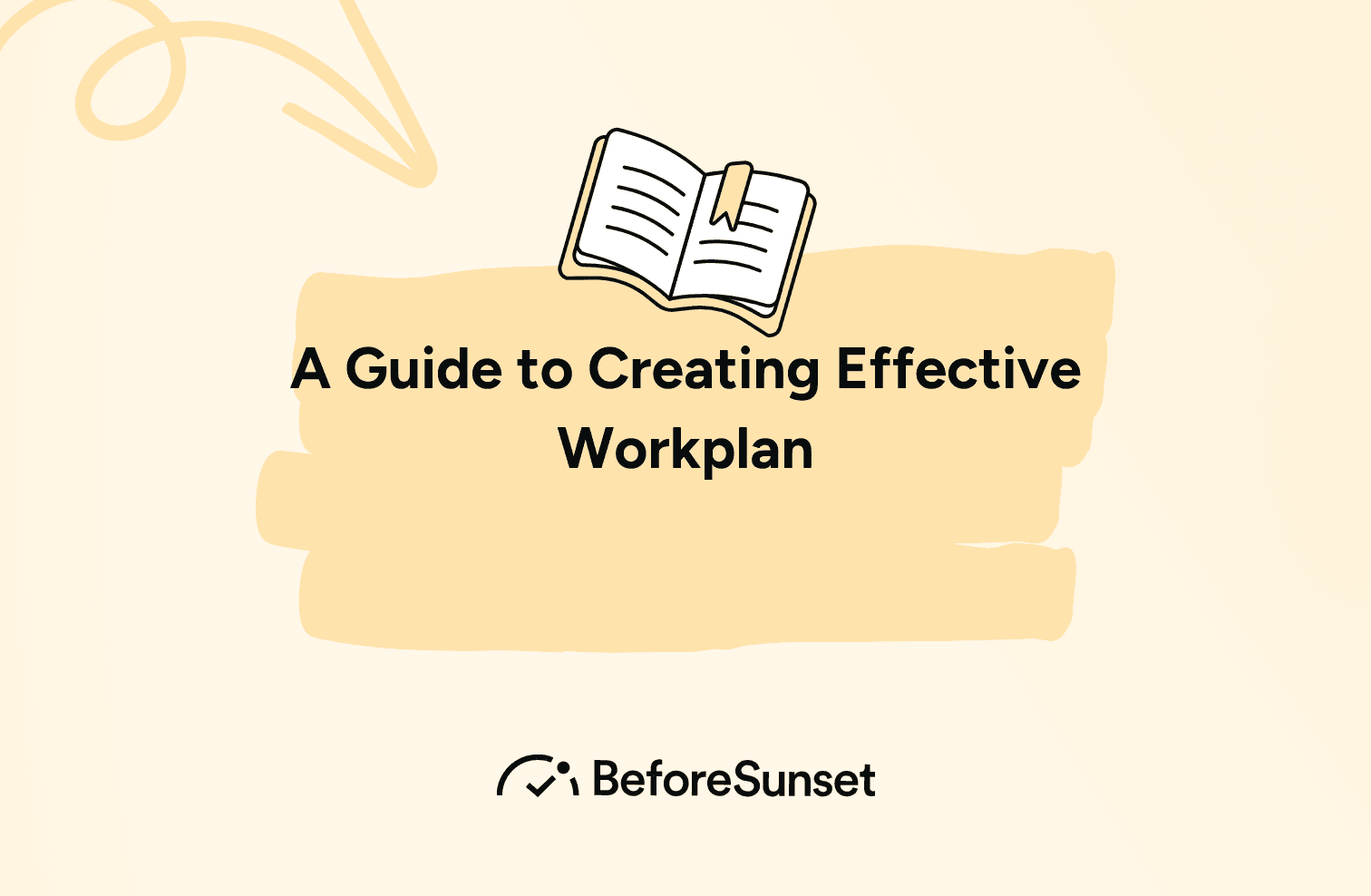Have you ever embarked on a project without a map? It can be a recipe for confusion, wasted time, and missed deadlines. The same goes for tackling work goals. That's where a workplan comes in – your essential roadmap to project completion.
What is a Workplan?
In today's fast-paced work environment, navigating complex projects and achieving ambitious goals requires a roadmap. That's where the concept of a work plan comes in. It's more than just a to-do list; it's a comprehensive and collaborative document that serves as the foundation for project success.
You might also like:
A Guide to Operational Planning: How to Streamline This Process
How Big Things Get Done: The Process of Achieving Ambitious Goals
Here's a deeper dive into what a workplan is and how it functions:
A Detailed Blueprint: A workplan is a detailed document that outlines the specific steps required to achieve a clearly defined goal. Imagine it as a blueprint for a building – it lays out the overall structure, identifies the necessary components, and specifies the order in which things need to be built.
Collaborative Effort: Creating a workplan is often a collaborative effort. Teams or individuals involved in the project come together to brainstorm, define objectives, and determine the most effective course of action. This collaborative approach ensures everyone is on the same page from the outset and fosters a sense of ownership for the project's success.
Breaking Down the Big Picture: A work plan doesn't just define the end goal; it breaks it down into manageable tasks. These tasks are the individual actions that need to be completed, step-by-step, to achieve the overall objective. By taking a large project and dividing it into smaller, more achievable tasks, a workplan reduces feelings of overwhelm and makes the project seem less daunting.
Assigning Ownership: An effective workplan assigns ownership to each task. Who on the team is best suited to handle a specific task? By clearly defining ownership, the workplan ensures accountability and eliminates confusion about who is responsible for what.
Establishing a Timeline: Deadlines are crucial for keeping a project on track. A workplan establishes a realistic timeline for completing each task and the overall project. This timeline provides a clear sense of urgency and helps team members prioritize their workload effectively.
A Living Document: While a workplan serves as a roadmap, it's not static. As the project progresses, there might be unforeseen challenges or changes in scope. A good workplan is flexible and can be adapted to reflect these changes. Regularly reviewing and updating the workplan ensures it remains relevant and continues to guide the project towards success.
In essence, a workplan is a powerful project management tool. By providing a clear roadmap, fostering communication, and promoting accountability, workplans significantly increase the chances of achieving your goals and objectives.
Why Use a Workplan?
Workplans offer a multitude of benefits:
Clarity & Focus: By laying out the project goals, tasks, and deliverables, a workplan ensures everyone involved is on the same page.
Improved Communication: The collaborative nature of creating a workplan fosters open communication and clarifies expectations for all team members.
Enhanced Time Management: Workplans establish deadlines and milestones, helping teams stay on track and avoid last-minute scrambles.
Identification of Risks & Resources: Through the planning process, potential roadblocks are identified, allowing teams to proactively develop solutions and ensure they have the necessary resources.
Increased Efficiency: A well-defined workplan minimizes wasted time and streamlines the project workflow.
Improved Project Success Rate: By providing a clear roadmap and facilitating communication, workplans significantly increase the chances of project success.
What Should a Workplan Include?
The specific content of a workplan can vary depending on the nature and size of the project. However, some key elements are generally included:
Project Goals & Objectives: Clearly define the overall aim of the project and the desired outcomes.
Deliverables: Outline the specific outputs or products expected at the project's conclusion.
Tasks & Activities: Break down the project into a series of manageable tasks, each with a clear description and assigned owner.
Timeline & Deadlines: Establish a realistic timeline for completing each task and the overall project.
Resources: Identify the necessary resources (e.g., budget, personnel, equipment) for project completion.
Communication Plan: Outline communication channels and meeting schedules to ensure everyone stays informed.
Risk Management Plan: Identify potential challenges and develop contingency plans to mitigate them.
Creating and Utilizing Your Workplan
Developing a workplan is an iterative process. Start by defining the project goals, and then collaborate with your team to brainstorm tasks, timelines, and resource needs. Use project management tools like software or spreadsheets to keep your plan organized and accessible.
Remember, your workplan is a living document. As the project progresses, review and update it regularly to reflect changes in scope, priorities, or deadlines.
Conclusion:
By incorporating workplans into your project management approach, you equip yourself and your team with a powerful tool for success. Workplans provide clarity, promote communication, and keep projects on track. So, before embarking on your next project, take the time to create a workplan and watch your success unfold!
Crafting Your Success: A Step-by-Step Guide to Writing a Workplan
Imagine conquering a mountain without a map. It wouldn't be pretty, right? Similarly, tackling work projects without a well-defined plan can lead to confusion, wasted time, and missed deadlines. Enter the workplan – your essential roadmap to reaching your goals.
This guide will take you through the process of creating a workplan, step-by-step.
Step 1: Define Your Destination – Goals & Objectives
The Big Picture: Start by clearly outlining the overall goals of your project. What do you aim to achieve? Be specific and ambitious, yet achievable.
Breaking It Down: Next, define the objectives – the measurable steps you'll take to reach your goals. Objectives should be SMART: Specific, Measurable, Achievable, Relevant, and Time-bound.
Step 2: Charting the Course – Tasks & Activities
Divide & Conquer: Now it's time to break down your project into manageable tasks. These are the individual actions that need to be completed to achieve each objective.
Who's in Charge? Assign ownership to each task. Who on your team is best suited to handle it? Clearly define each task's scope and ensure everyone understands their responsibilities.
Step 3: Keeping Time – Timeline & Deadlines
Realistic Roadmap: Develop a realistic timeline for completing each task and the overall project. Estimate the time required for each task, considering potential dependencies between tasks.
Milestone Mania: Establish key milestones along the way. These act as checkpoints to track progress and ensure you're on track.
Step 4: Gathering Supplies – Resources
What You Need: Identify the resources necessary to complete the project successfully. This might include budget, personnel, equipment, software, or any other tools needed.
Ensuring Availability: Determine if the necessary resources are readily available or if you need to secure them before starting the project.
Step 5: Staying Connected – Communication Plan
Clear Channels: Establish clear communication channels and meeting schedules to keep everyone informed about project progress, roadblocks, and changes.
The Power of Collaboration: Regular communication fosters collaboration and ensures everyone is on the same page.
Step 6: Anticipating the Journey – Risk Management
Foreseeing Challenges: Brainstorm potential roadblocks or risks that could hinder project progress.
Having a Back-Up Plan: Develop contingency plans for identified risks. What will you do if a key resource becomes unavailable? How will you handle unexpected delays?
Step 7: Building Your Map – Formatting & Tools
Choose Your Weapon: There's no one-size-fits-all format for a workplan. Choose a tool that works for you and your team. Popular options include project management software, spreadsheets, or even simple documents.
Keeping it Organized: Structure your workplan in a clear and concise way. Include sections for goals, tasks, deadlines, and resources, making it easy for everyone to navigate.
Step 8: The Journey Begins – Implement & Adapt
Putting It into Action: With your workplan in hand, it's time to start taking action!
Embrace Change: Remember, a work plan is a living document. As the project progresses, review and update your plan regularly to reflect changes in scope, priorities, or deadlines.
Conclusion:
By following these steps and investing time in creating a comprehensive work plan, you significantly increase your chances of project success. So, grab your metaphorical compass and map (your work plan!), and embark on your next project with confidence!
BeforeSunset AI: Your Supercharged Workplan Copilot
Crafting a work plan is essential, but let's face it, it can be time-consuming and sometimes tedious. That's where BeforeSunset AI steps in as your secret weapon, transforming your work from a static document into a dynamic tool that propels you toward success.
BeforeSunset AI streamlines your work plan creation process in several ways:
Effortless Task Breakdown: Tired of staring at a blank page trying to figure out your next steps? BeforeSunset AI's AI-powered brainstorming tool helps you break down your project goals into actionable tasks with ease. Simply enter your objectives, and BeforeSunset AI suggests relevant and achievable tasks, saving you valuable time and mental energy.
Smart Scheduling & Time Management: Estimating task durations can be tricky. BeforeSunset AI integrates with your calendar and analyzes your historical data to suggest realistic timeframes for each task. This ensures your workplan is grounded in reality and helps you avoid overcommitting yourself.
Real-Time Progress Tracking & Collaboration: BeforeSunset AI goes beyond a static document. It transforms your work into a collaborative workspace. Track your progress in real time, assign tasks to team members, and monitor overall project health. This fosters transparency, and accountability, and keeps everyone on the same page.
Dynamic Adjustments & Risk Management: BeforeSunset AI understands that projects rarely go exactly according to plan. Unexpected roadblocks or changes in scope can arise. BeforeSunset AI's flexible platform allows you to easily update your workplan as needed. You can adjust deadlines, re-allocate resources, and adapt your approach based on real-time insights.
BeforeSunset AI doesn't just help you create a work plan; it empowers you to use it effectively. With its suite of features, BeforeSunset AI becomes an active partner in your project management journey. It helps you stay focused, manage your time efficiently, and adapt to changing circumstances, ultimately leading you to achieve your goals with greater ease and success.
Ready to take your workplan to the next level? Sign up for BeforeSunset AI today and experience the power of AI-driven project management!

